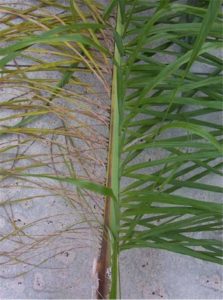Fusarium Wilt Now Attacks Queen Palms and Mexican Fan Palms
The fungal pathogen that has long been the bane of beautiful and expensive Canary Island date palms has been found fatally attacking queen palms in Fallbrook and experts believe that Mexican fan palms will also be susceptible. While it’s tempting to see North County distinguished as the first confirmed record of this pathogen in California, don’t be distracted from how very very (very) bad this news is. Queen and Mexican fan palms are two of the most common and iconic trees in our region. Unfettered, this disease could literally transform the Southern California landscape.
Fusarium Wilt is Fatal
 No cure exists for fusarium wilt. Once infected, a tree should be removed as quickly as possible and its debris destroyed to prevent the spread of the disease.
No cure exists for fusarium wilt. Once infected, a tree should be removed as quickly as possible and its debris destroyed to prevent the spread of the disease.
Prevent the Spread
Fusarium wilt is known to spread between trees on infected tools as well as through the movement of soil and water from infected to healthy plants. It is not yet known whether the pathogen can be spread by wind and birds.
Alert Your Landscape and Tree Care Companies to Do the Following:
- Thoroughly disinfect all tools after use on EACH PALM. This includes rakes, shovels and hoes as well as saws.
- Use manual pruning saws, NOT CHAINSAWS. Chainsaws are difficult to disinfect properly so manual saws are recommended. Take these precautions even if the palm appears healthy since symptoms may not yet be visible on an infected tree.
- Prune only dead and dying leaves. Do not shape “pineapples”. Do not skin or peel off leaf bases. Wounds can facilitate entry of the pathogen into a tree so caution should be used not to wound trees in any way.
- Avoid pruning during windy weather to prevent infected sawdust from traveling to and infecting nearby trees.
- Avoid movement of soil from around palms to other areas and control water runoff.
- If an infected tree is found:
- Remove the tree immediately.
- Ideally, excavate the root ball and remove the intact tree with a crane.
- Contain the area with plastic or wooden barriers so that all infected material is removed from the site.
- Incinerate infected trees and site material, or send them to a landfill (NOT a waste recycling program).
Identifying Symptoms
 If you aren’t already familiar with fusarium wilt, here are a few signs to watch for:
If you aren’t already familiar with fusarium wilt, here are a few signs to watch for:
- One side of the frond is yellowing while the other half appears green and healthy
- The frond is yellower or browner on one side than the other
- Symptoms moving up the canopy from lower to upper leaves
- Canopies with larger than normal numbers of brown, dead leaves when compared with green leaves
- In regularly pruned trees, look for canopies with fewer living fronds than normal
Get Help
If you think you may have fusarium wilt on your property, contact an arborist immediately. We are here to help. Contact us now.
